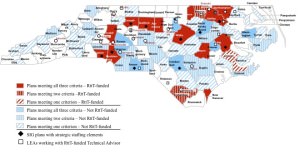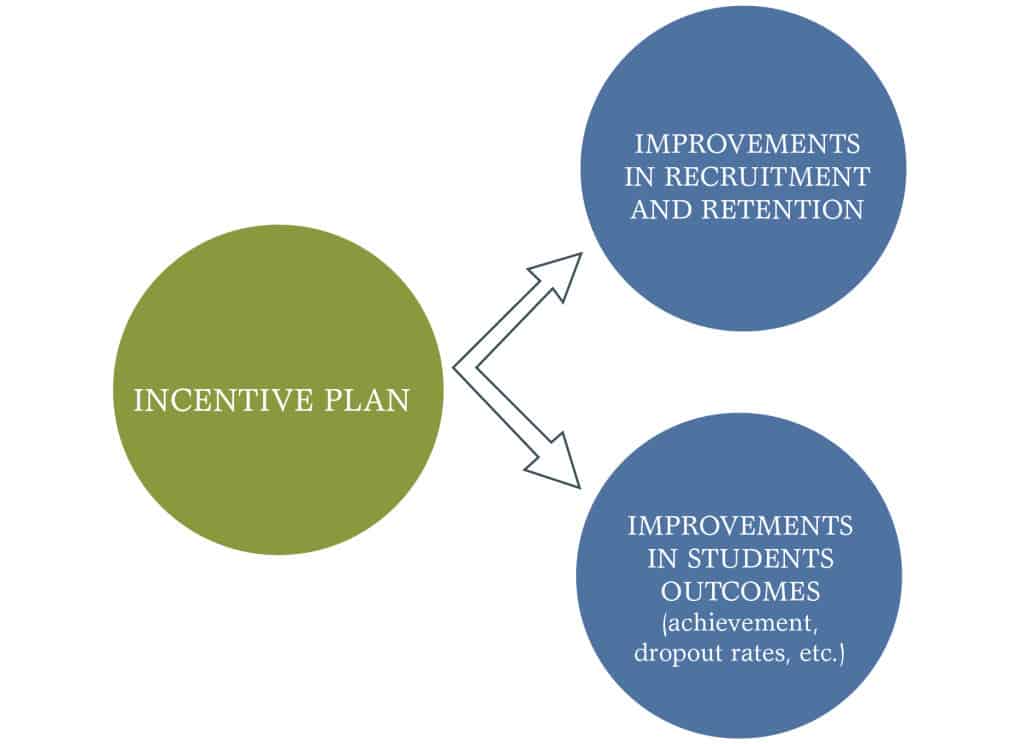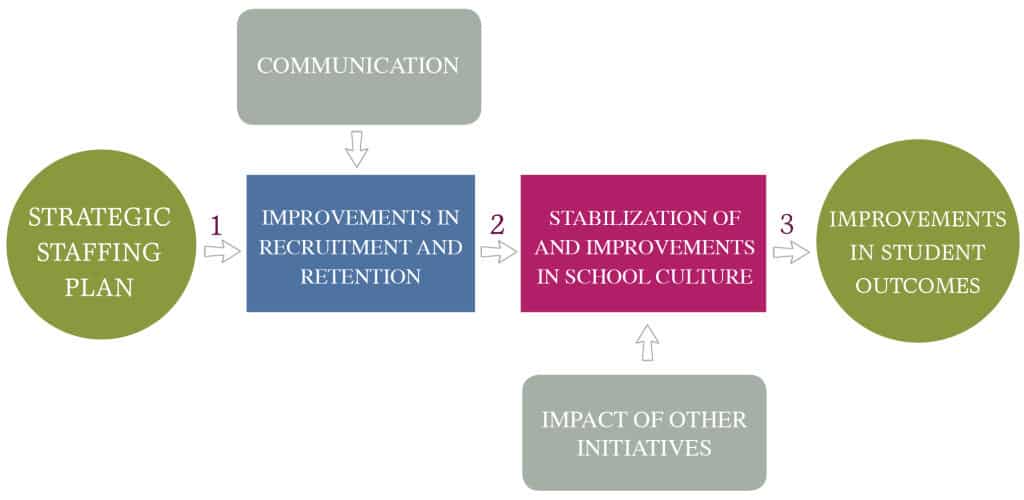

Is all teaching created equal?
Lost in the shuffle of North Carolina’s debates in 2014 about whether and by how much to raise teacher pay was a fundamentally more important question:
Should teacher pay be based on experience and credentialing alone – that is, should it be the same for all teachers who have similar levels of experience and backgrounds – or should other factors – performance, duties, or even geography – also be considered?
The question matters not only because of its possible implications for reduction in the state’s annual teacher turnover rate (which now hovers around 14% a year) but also because of its growing popularity as a way of thinking about how to impact several other policy outcomes – some that may be influenced by changes in pay, but some for which there is little evidence that pay differentiation (paying different salaries to teachers with the same years of experience) will lead to desired outcomes.
Pay differentiation has been suggested as a way to recruit teachers to the state or to struggling schools; incentivize teachers-in-training to license in hard-to-staff subject areas; and, most typically, reward and retain teachers who are deemed effective, based on their students’ achievement (“pay-for-performance”).
North Carolina is no stranger to differentiating pay for teachers with similar years of experience and degrees, but until very recently such differentiation has come only in the form of group bonuses based on school-wide student performance on state end-of-grade and end-of-course tests. These bonuses ended at the state level in 2008.
But does pay differentiation actually work? As it turns out, the answer to that question depends on one’s definition of “work.”
If by “work” we mean that differentiating pay directly, immediately, and positively impacts student academic achievement, then the answer, while not quite resoundingly so, is a qualified “no.” Findings from the handful of recent studies that meet high standards for quality research are clear and consistent:
- There is little evidence that traditional, standalone performance incentives increase student achievement or behavior outcomes;
- In general, it does not appear to matter whether the bonus is individual or team/school-based – the results appear to be the same;
- There is little evidence that traditional performance incentives change teacher behavior (classroom teaching practices, professional behavior, etc.); and
- The size of the bonus does not appear to make a difference.1
If we broaden the definition of “work” to include other outcomes – such as teacher recruitment or retention – the answer leans closer toward “maybe,” depending on the circumstances. For example, there is preliminary evidence – though only from one experimental program – that job-related consequences (instead of direct changes in pay) connected to teacher effectiveness labels such as “ineffective” and “highly effective” (instead of connected directly to student outcomes) may lead to improvement in the overall quality of a school’s teachers through increased performance among a handful of teachers coupled with the attrition of other teachers – though this outcome may not be tenable for districts that struggle in the first place to retain enough teachers to fill classrooms and that might prefer instead initiatives that strengthen the teachers they already have.
Moving beyond pay differentiation
So, where does that leave us? Does this mean that differentiating pay is a waste of time and money? Not necessarily. Before abandoning the idea, we first may need to shift our thinking with respect to what we hope pay differentiation will achieve, and how quickly it will do so.


Through our work cataloging over 70 experiments with differentiated teacher pay across North Carolina between 2010 and 2014,2 members of the Consortium for Educational Research and Evaluation-North Carolina3 have begun to formulate a more complex approach – one that incorporates differentiated pay alongside other components – that potentially might work.
Though it may sound strange at first, the first step in this process is to take student outcomes out of the equation for the short term. Instead, we might be better off replacing these with a goal for schools to build environments in which positive student outcomes are more likely. In other words, we need to move from this perspective:


to this one:


In the traditional approach (Figure 1), we expect the promise of pay-for-performance (“P4P”) and other forms of higher pay (the green circle on the left) to attract, retain, and improve teachers (the top blue circle on the right), with a simultaneous and immediate pay-off in student outcomes (the bottom blue circle on the right). As noted above, the evidence against the likelihood of this happening is widespread and mounting.
In its place, schools and districts across the country but also right here in North Carolina are using whatever funds they can get to experiment with variations on a more nuanced but simple-to-understand alternative often referred to as strategic staffing (Figure 2).
Strategic staffing refers to a broad category of approaches to staffing that purposefully redistribute more effective educators into lower-performing districts, schools, and classrooms. In many cases, these approaches include pay differentiation as part of (but not all of) an overall plan.
They move teachers among schools and classrooms in ways that maximize available talent to meet a district’s or school’s specific needs.
There are several differences between these strategic approaches and the classic one-size-fits-all pay-differentiation approach. First, these approaches often include more than one type of incentive (the orange circle on the left) – differentiated pay among them, but also things like low-rent or free housing for teachers and access to special equipment. They also vary in how incentives are earned; some reward teachers based on quantitative and qualitative measures of their performance, but others reward differences in responsibilities, in leadership, or even in the challenges of different teaching assignments. Furthermore, the plans do not assume that all we need in order to get more out of teachers is financial motivation; instead, they assume that some teachers are better fits for some teaching situations than others. They move teachers among schools and classrooms in ways that maximize available talent to meet a district’s or school’s specific needs.
Most importantly, the majority of these alternative models are built on the assumption that there is no immediate connection between incentives and increased student performance (the green circle on the far right). Instead, these models typically operate under the assumption that differentiated pay and other immediate rewards and strategies are best used as the fundamental building blocks for longer-term efforts to first reduce teacher turnover and then change school cultures (the yellow and blue boxes). Only once a school or district has those two factors under control can student outcomes change in meaningful ways.
These approaches understand that no plan on its own will create desired change; also important is the context in which that plan is set (gray lozenges on the top and bottom of Figure 2) – things like whether the plan coordinates or conflicts with other initiatives in a school or district, or how well the purpose and structure of the plan is communicated to all of the relevant stakeholders – from teachers to administrators to even parents and students.
Strategic staffing in action
Why is the second model more likely than the first to be more responsive to the reality on the ground in our schools and districts? Put simply, as much as we would like to think of our schools and districts as uniform places with common characteristics, the truth is that, at least here in North Carolina, they are about as different from one another as can be imaginable in the same state. What works in Murphy is not likely to work in Manteo. Or in Murfreesboro, for that matter.
The more impactful pay differentiation plans are likely to be those that not only address several factors of overall school culture but also do so in a way that is sensitive to the vagaries of individual school settings – robust and multifaceted plans that reflect the unique needs of individual schools and districts.
The more impactful pay differentiation plans are likely to be those that not only address several factors of overall school culture but also do so in a way that is sensitive to the vagaries of individual school settings …
As an example of why the traditional, short-term, one-size-fits-all approach to pay differentiation is likely to fall short of our expectations, consider the POINT project from Nashville, Tennessee. The project rewarded middle school math teachers up to $15,000 each based on their students’ performance. Research findings suggest that the incentive did not have the intended effect, but even if it did, how likely is it that a small, rural North Carolina county that struggles to maintain basic services would be able to meet these pay levels? Even if it could (for instance, through a limited-time federal grant or a grant from a North Carolina nonprofit), it would be unlikely to be able to sustain such a program after grant money ran out. Similarly, plans designed for larger school systems that are based on the ability to move teachers to different schools would be a poor fit for a small school district with only one high school.
Our schools and districts already know the importance of local customization. When given access to federal dollars for four years through the Race to the Top (RttT) grant, not only did most of our state’s districts develop some sort of strategic staffing plan, but they also did so in a fascinatingly diverse array of ways, reflecting their innate understanding of the need to custom-fit their staffing models to the needs of their environments. Consider a few examples from across the state – some traditional and some less so:
- Columbus County Schools – Columbus County provides special training for lead teachers who support the highest-need schools in the district. The lead teachers typically are assigned to one school, where they provide a variety of services, based on each school’s needs, including: facilitation of professional learning communities; professional development; modeling of effective implementation of strategies and practices learned in their professional development; and monitoring of current school initiatives, teachers’ instructional practices, and student progress.
- Winston-Salem/Forsyth County Schools – WSFCS sponsors three coordinated strategic staffing plans: (1) Project Enrich, which prepares teachers to work in low-achieving schools; (2) Equity+, which provides recruitment and retention bonuses for teachers in schools with large low-income populations; and (3) STAR3, a federal Teacher Incentive Fund-funded whole-school turnaround model that includes a pay-for-performance component that awards up to $10,500 a year to effective educators.
- Guilford County Schools – GCS’s Mission: Possible plan, now in its ninth (though, sadly, possibly final) year, includes a complex recruitment, retention, and performance-based compensation system for educators who teach in or move to one of 44 identified schools.
- Charlotte-Mecklenburg Schools – CMS’s most recent experiment with strategic staffing is its Project Leadership and Investment for Transformation (Project L.I.F.T.) initiative – a school redesign initiative focused on underperforming schools. Four L.I.F.T. schools incorporated an Opportunity Culture strategic staffing model into their overall transformation plans for 2012-13, and for the 2014-15 school year, 17 more CMS schools have adopted similar plans. The Opportunity Culture model differentiates teacher roles and responsibilities and then matches compensation to those roles and responsibilities. Pay is based in part on responsibility level; supplements are tied to responsibilities but not directly to student outcomes.
- Moore County Schools – All instructional staff employed at Moore County’s federally-funded School Improvement Grant school receive a $5,000 incentive annually to compensate them for the additional training and time required to participate in the school’s reform process. As part of this process, instructional staff undergo frequent observations and evaluations to determine areas for professional development support, which is then tailored for individual teachers based on their specific identified needs (e.g., differentiated instruction, cultural awareness, effective engagement-based learning strategies, etc.). All instructional staff also are afforded opportunities to work regularly with instructional coaches in literacy and math.
Making strategic staffing work for North Carolina
As noted above, this expanded vision of strategic staffing will require policymakers and school administrators to change their short-term expectations. In addition, there are several steps that the state and districts can take to help us better understand how well these more complex approaches to staffing are able to solve fundamental schooling issues:
- Direct resources to fully-realized strategic staffing plans rather than to incentive-only plans. By now it should be clear that performance incentives alone may not be the best strategy for increasing the effectiveness of teachers or the quality of schooling for low-performing students and schools.
- Develop and maintain a comprehensive communications plan. Clear, consistent, and constant communication between implementers and educators is critical to the success of the recruitment and retention aspects of any staffing initiative.
- Design plans with school environment goals – e.g., recruitment and retention of effective teachers coupled with strategic planning – rather than student achievement goals. There is growing evidence that strategic staffing plans can impact intermediate outcomes that may then have longer-term impacts on student achievement.
- Plan for sustainability. Even the longest-running, most robust, and most successful plans across the state struggle to maintain ongoing funding; districts and schools will need help pursuing multiple funding sources and planning for the end of each funding source several years in advance.
- Work together across school district boundaries. Currently, there is no formal mechanism in place for districts to learn from each other’s experiences with the dozens of local-level plans out there now. The state should work with districts interested in developing or revising a strategic staffing plan to find ways to connect them with others across the state who can share their experiences and learnings.
- Explore multiple plan options. Similarly, districts interested in developing or revising a strategic staffing plan should consider multiple approaches, and they should be open to early experimentation with those approaches to support the development of an optimal plan for each district’s specific conditions.4
- Review the latest research. In addition to consulting with each other, districts also should stay current on constantly-updated findings about the effectiveness of new staffing strategies and work to share those findings with administrators and their human resources departments. As approaches to strategic staffing continue to expand, so, too, do data and evidence about their feasibility, sustainability, and effectiveness.
Ultimately, none of this work is likely to have much impact unless the state and participating districts are willing to conduct rigorous and objective evaluations of the most promising models. Unfortunately, the type of evaluation needed to answer a lot of these questions often is out of reach here in North Carolina, primarily because very few strategic staffing plans last long enough to allow for accurate measurement of program impacts across time. Sustained investment from the state and interested grantors in at least a few well-designed plans, however, could go a long way toward helping us figure out how to get what we pay for.
Editor’s Note: Trip Stallings is the husband of Mebane Rash, the CEO of EdNC.



